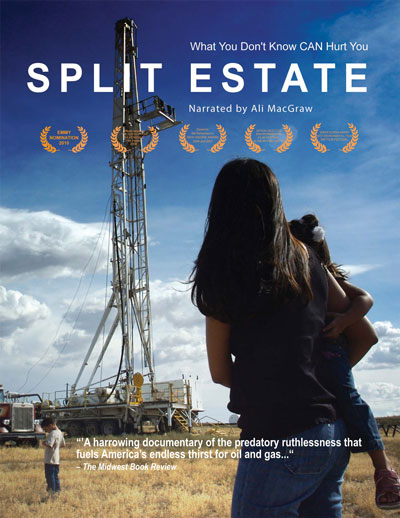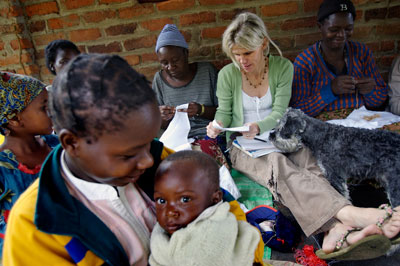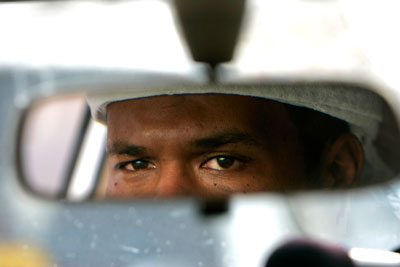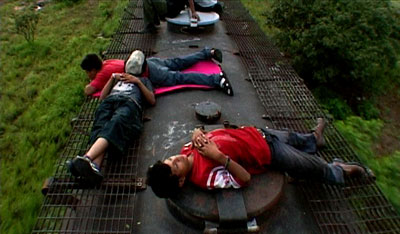Imagine discovering that you don’t own the mineral rights under your land, and that an energy company plans to drill for natural gas two hundred feet from your front door. Imagine having little recourse, other than accepting an unregulated industry in your backyard. Split Estate maps a tragedy in the making, as citizens in the path of a new drilling boom in the Rocky Mountain West struggle against the erosion of their civil liberties, their communities and their health. Zeroing in on Garfield County, Colorado, and the San Juan Basin, this clarion call for accountability examines the growing environmental and social costs to an area now referred to as a “National Sacrifice Zone.” This is no Love Canal or Three Mile Island. With its breathtaking panoramas, aspen-dotted meadows, and clear mountain streams, this is the Colorado of John Denver anthems — the wide-open spaces that have long stirred our national imagination. Exempt from federal protections like the Clean Water Act, the oil and gas industry has left this idyllic landscape and its rural communities pockmarked with abandoned homes and polluted waters. One Garfield County resident demonstrates the degree of benzene contamination in a mountain stream by setting it alight with a match. Many others, gravely ill, fi ght for their health and for the health of their children. All the while, the industry assures us it is a “good neighbor.” Ordinary homeowners and ranchers absorb the cost. Actually, we all pay the price in this devastating clash of interests that extends well beyond the Rockies. Aggressively seeking new leases in as many as 32 states, the industry is even making a bid to drill in the New York City watershed, which provides drinking water to millions. As public health concerns mount, Split Estate cracks the sugarcoating on an industry touted as a clean alternative to fossil fuels, and poignantly drives home the need for real alternatives.
Summary info for schedule – will be hidden on film page

Split Estate
76-minutes
Screening day / time
Split Estate
Split Estate
Filmmaker Notes:
In July of 2006, I read a story in OnEarth magazine, published by the Natural Resources Defense Council, that was so moving to me that I left my editing room to shoot my first fi lm. It was about a woman named Laura Amos from Garfield County, in Colorado, the state where I grew up. Laura had developed a rare form of cancer as a result of natural gas drilling in her neighborhood. She became an activist in her community and then a plaintiff, when she sued the company responsible for her problems. After years of struggle, she was silenced. She came to a monetary settlement with Encana Corporation, which stipulated that she not tell her story ever again. But this, I knew, was a story that needed to be told far and wide. I could not believe that an energy company could come in on land that you own, and drill at will without your permission as close as 150 feet from your front door. I also couldn’t believe that the gas and oil industry’s practices, which include a chemical process called hydraulic fracturing or ‘fracking’, are largely unregulated and making people sick. I called residents in Garfi eld County, recommended by the Oil and Gas Accountability Project, rented some camera equipment and drove up to Colorado. I did not know at the time that it would become a full-length fi lm, but was drawn into the story immediately when I met the people of the western slope of Colorado. Their communities had been shattered by the industry and their stories were heartbreaking. I saw that beautiful wild areas where I had camped with my father as a child were now pin-cushioned with gas wells. Much to my surprise, the story of oil and gas in the Rockies became a very personal one for me, merely nine months into filming. Tecton Energy came into Santa Fe County and began drilling in the Galisteo Basin a few miles from my home in New Mexico. Ultimately, a rough cut of the fi lm was used as an educational tool by a grassroots coalition in Santa Fe County to help establish one of the strongest ordinances in the country and the industry backed off for the time being. Today, however, the crisis deepens and the film is more relevant than ever to communities in the US and beyond, as natural gas development ramps up all over the globe. Natural gas is being sold to the American public as the answer to all of our energy woes. It’s championed as “the clean fossil fuel,” and “the transition fuel,” as we look to reduce our greenhouse gas emissions and our dependence on foreign oil. But, there is no such thing as a “clean” fossil fuel; nor, is there clean extraction, as citizens on the frontlines of the drilling boom will attest. It was always my intent to get the fi lm in the hands of the people and communities that need it most. Now, the Split Estate outreach campaign is drawing upon the storytelling of the film and the resources we have developed to educate communities about the true costs and long-term consequences of socially and environmentally irresponsible drilling. I hope the fi lm will empower citizens to take action, and that it will do its part to catalyze progressive shifts in local and federal energy policy.



